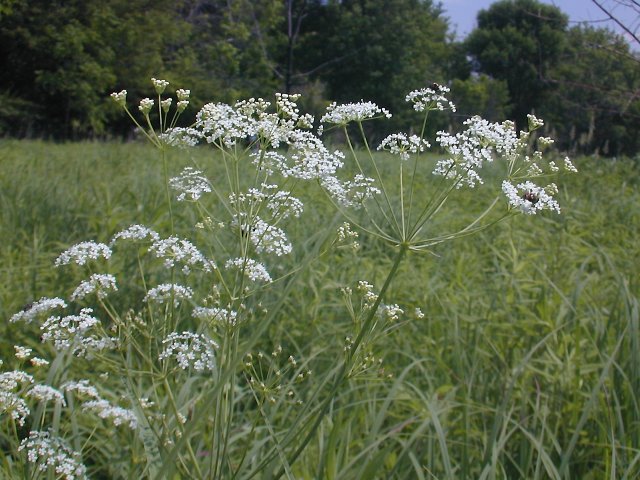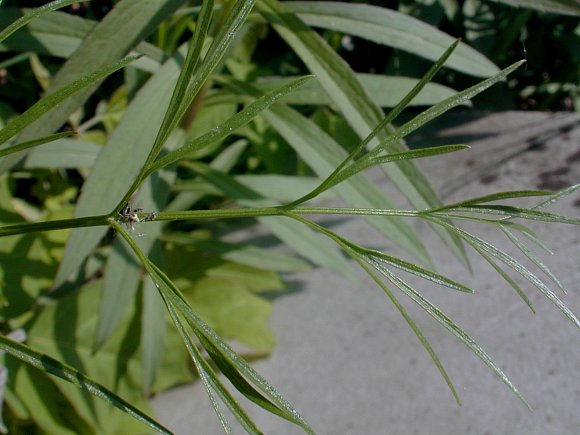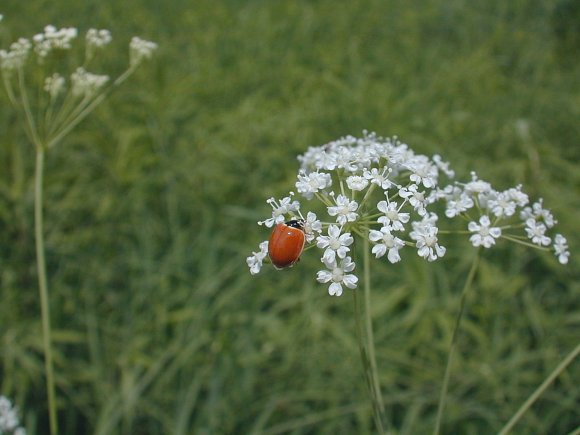Description: This herbaceous perennial plant is 2-3½' tall, branching sparingly. The slender stems are round and hairless. The alternate compound leaves occur sparingly along the stems; they are doubly pinnate, and about 8" long and half as wide. The slender leaflets are up to 1/8" (3 mm.) across. They often have 1-3 lobes, but their margins are smooth. The upper stems terminate in compound umbels with small white flowers. A typical umbel is about 6" across and has about 12 umbellets; these umbellets are loosely arranged, rather than compressed together. An umbellet is about 1" across and has 7-21 flowers.

Each flower is
about 1/8" (3 mm.) across, with 5 white petals that are notched in the
middle,
and 5 green sepals that are small and triangular. There are also up to
5 white stamens with 5 white anthers that are potentially observable;
frequently, there appears to be fewer than 5 of these reproductive
structures because they are fragile and short-lived. The blooming
period occurs during early summer and lasts about 2 weeks. There is no
noticeable floral scent. The root system is tuberous, which enables
this plant to develop quickly during the spring and early summer. After
blooming, it quickly fades away and becomes dormant for the rest of the
year.
Cultivation:
The preference is light shade to full sun, and moist to slightly dry
conditions. Wild Dill often grows in soil that is rich and loamy; it
also tolerates some clay or rocky material. This plant should be
cultivated more often in wildflower gardens.

Range &
Habitat:
The native Wild Dill occurs occasionally in NE and central Illinois,
but it is
rare or absent elsewhere (see Distribution
Map). Habitats include mesic black soil prairies, openings or
edges near woodlands, areas along woodland paths, thickets,
limestone glades, and bluffs. It often grows in grassy areas, but is
easy to overlook, except during the short blooming period.
This plant is more typical of high quality habitats than disturbed
areas.
Faunal Associations:
The nectar of the flowers attracts many small bees, wasps, flies, and
beetles. Among the flies, are such visitors as biting midges, Syrphid
flies, thick-headed flies, Tachinid flies, flesh flies, bottle flies,
Muscid flies, Chloropid flies, and others. Among the wasps, are such
unusual visitors as cuckoo wasps and various parasitoid wasps,
including the Chalcid, Perilampid, Eucoilid, Figitid, and Ichneumonid
wasps. Little is known about this plant's relationship to mammalian
herbivores; because the foliage is not known to be toxic, it is
probably consumed by them occasionally.

Photographic
Location:
The photographs were taken at Meadowbrook Park in Urbana, Illinois,
and at
Prospect Cemetery Prairie in Ford County, Illinois.
Comments:
This is an ethereal plant that is lovely while in bloom; unfortunately,
this doesn't last very long. From a distance, Wild Dill may appear to
be an early blooming Daucus carota (Wild Carrot),
but closer inspection of the foliage and flowers will reveal
significant differences between these two plants. What sets Wild Dill
apart from many other white-flowered members of the Carrot family is
the season of bloom (early summer) and the slender, delicate leaves
(not wider than 1/8" across). Also, it should not be confused with Anethum
graveolens (Cultivated Dill); this familiar annual herb from
the Old World has yellow flowers. Another common name for Perideridia
americana is 'Thicket Parsley.'